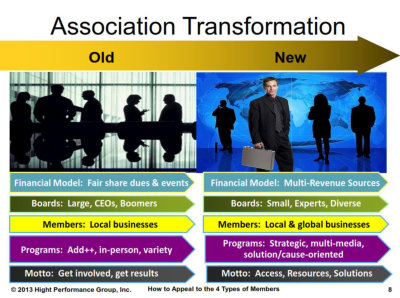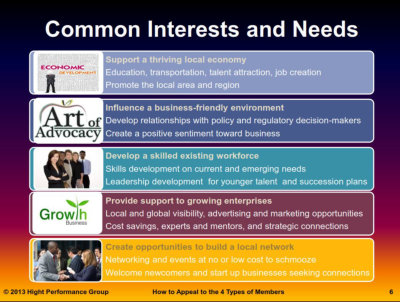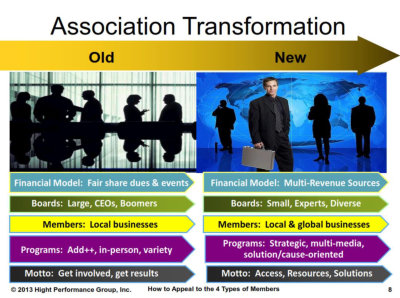For as long as I can remember, the message to members was “Get involved, get results.” This implied that if members wanted to gain benefits from us, they had to come to events, belong to a committee, or be active in grassroots advocacy initiatives to drive favorable business legislation. Inadvertently, this message also told members that if they couldn’t get “involved” in the face-toface opportunities we provide, they weren’t likely to reap the benefits they anticipated.
 I agree that when members actively and consistently engage in networking and committee initiatives, they are more apt to know what’s going on and can develop deeper relationships with other members. It’s the same recipe for what it takes to make social media initiative effective. It doesn’t matter how many Facebook friends, LinkedIn connections or Twitter followers one has—if you’re not reading, sharing, or contributing, you can be out of the loop and lose touch and favoritism pretty quickly.
I agree that when members actively and consistently engage in networking and committee initiatives, they are more apt to know what’s going on and can develop deeper relationships with other members. It’s the same recipe for what it takes to make social media initiative effective. It doesn’t matter how many Facebook friends, LinkedIn connections or Twitter followers one has—if you’re not reading, sharing, or contributing, you can be out of the loop and lose touch and favoritism pretty quickly.
But membership in a professional or trade association isn’t another social media venue. People have so many choices today to be profiled, get involved, collect information, and network with others. Time poverty prevents so many members from attending programs and events that are either “one-offs” or offered on days/times when they can’t attend. And managing so many different memberships can be time-consuming and unproductive.
We also have to realize that individuals and organizations belong to associations for different reasons. Some join because of us—why we exist, how we do it, and what we get done. Many others join because it’s more about them—what they want to communicate to the community about their brand, what needs or interests they have to address, and what they can get from us.
 The new motto we’re rallying around is focused on: Access, Resources, Solutions and realizing that the interests/needs the motto communicates can mean different things to different groups. Our days of selling the same benefits to all prospects and members are behind us. The bottom line is that one size fits no one. We must develop different value propositions to communicate and serve a diverse membership base. That starts with an understanding of the various segments of your audience (both members and prospects), what’s important to them, and how these diverse needs are met through the association.
The new motto we’re rallying around is focused on: Access, Resources, Solutions and realizing that the interests/needs the motto communicates can mean different things to different groups. Our days of selling the same benefits to all prospects and members are behind us. The bottom line is that one size fits no one. We must develop different value propositions to communicate and serve a diverse membership base. That starts with an understanding of the various segments of your audience (both members and prospects), what’s important to them, and how these diverse needs are met through the association.
In our webinar, How to Appeal to the 4 Types of Members, we discussed common interests and needs of members and prospects. This chart reflects a high level description of the most common ones. Of course, there are a few other “themes” that could be added. Learn more about the webinar.
We recommend that you develop your own themes by communicating with your current and nonmembers. This is the foundation of understanding your different target audiences and what matters to them.
The webinar also shared The Member Profile Matrix and how each quadrant portrayed a type of member with specific values, needs and interests. We discussed how the Matrix could be used to evaluate current benefits, identify service gaps, and to develop a tiered benefits model.
 Our webinar, The VOI of Membership is Greater than the ROI, focuses on developing value propositions that resonate with the different types of members. Lessons learned from the webinar can enhance how we communicate the value of membership. Learn more about the webinar.
Our webinar, The VOI of Membership is Greater than the ROI, focuses on developing value propositions that resonate with the different types of members. Lessons learned from the webinar can enhance how we communicate the value of membership. Learn more about the webinar.
